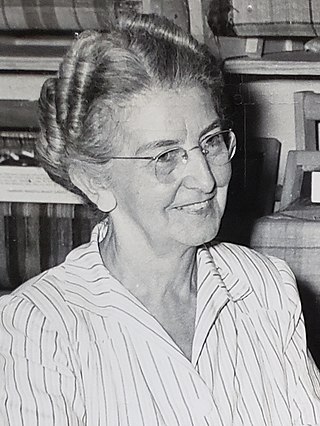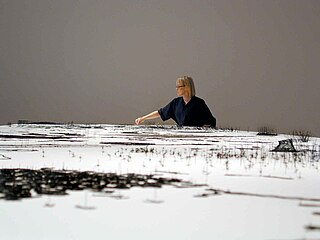Related Research Articles

Ethel Mary Partridge, Ethel Mary Mairet RDI, or Ethel Mary Coomaraswamy was a British hand loom weaver, significant in the development of the craft during the first half of the twentieth century.
Maya textiles (k’apak) are the clothing and other textile arts of the Maya peoples, indigenous peoples of the Yucatán Peninsula in Mexico, Guatemala, Honduras, El Salvador and Belize. Women have traditionally created textiles in Maya society, and textiles were a significant form of ancient Maya art and religious beliefs. They were considered a prestige good that would distinguish the commoners from the elite. According to Brumfiel, some of the earliest weaving found in Mesoamerica can date back to around 1000-800 B.C.E.

Ada K. Dietz was an American weaver best known for her 1949 monograph Algebraic Expressions in Handwoven Textiles, which defines a novel method for generating weaving patterns based on algebraic patterns. Her method employs the expansion of multivariate polynomials to devise a weaving scheme. Dietz' work is still well-regarded today, by both weavers and mathematicians. Along with the references listed below, Griswold (2001) cites several additional articles on her work.

Anne Wilson is a Chicago-based visual artist. Wilson creates sculpture, drawings, Internet projects, photography, performance, and DVD stop motion animations employing table linens, bed sheets, human hair, lace, thread and wire. Her work extends the traditional processes of fiber art to other media. Wilson is a professor in the Department of Fiber and Material Studies at The School of the Art Institute of Chicago.

Dorothy Wright Liebes was an American textile designer and weaver renowned for her innovative, custom-designed modern fabrics for architects and interior designers. She was known as "the mother of modern weaving".
Mary Ellouise Black, an occupational therapist, teacher, master weaver and writer, created almost single-handedly a renaissance in crafts in Nova Scotia in the 1940s and 1950s. Her best-known book, ‘’The Key to Weaving", was published in 1945 and has since run to 3 editions and numerous printings. Its clarity is without parallel, and, more than half a century later, it remains a handweaver's prime source of information.

Trude Guermonprez, born Gertrud Emilie Jalowetz, was a German-born American textile artist, designer and educator, known for her tapestry landscapes. Her Bauhaus-influenced disciplined abstraction for hand woven textiles greatly contributed to the American craft and fiber art movements of the 1950s, 60s and even into the 70s, particularly during her tenure at the California College of Arts and Crafts.
Polly Barton is an American textile artist.
Bhakti Ziek is an American artist known for narrative weavings incorporating contemporary jacquard technology. She has been active in the contemporary fiber field for over four decades as an artist, author, teacher and lecturer. Ziek currently resides in Santa Fe, NM.

Berta Frey was a well-known New York weaver, who spoke and taught about weaving techniques for many years. She was one of the founders of the Handweavers Guild of America.
Yvonne Sloan is a New Zealand weaver and textile artist.
Mary Meigs Atwater was an American weaver. She revived handweaving in America by collecting weaving drafts, teaching and writing; Handweaver and Craftsman called Atwater "the grand dame and grand mother of the revival of handweaving in [the United States]".
Lawrence Rogers Blinks was an American biologist with research interests in photosynthesis and electrophysiology. He served as the editor of the Annual Review of Plant Physiology for 1956.
Suzie Liles is an American fiber artist, master weaver, the owner of the Eugene Textile Center and co-owner of Glimakra USA, in Eugene, Oregon.
Eugene Weavers' Guild is a non-profit organization of weavers, spinners, and other fiber artists in Eugene, Oregon, in the U.S. It was founded in 1946 and has been meeting monthly for more than seventy years. As of 2016, the Guild included 85 members, ranging in skill from hobbyist to professional weavers, from Eugene, Springfield, and rural communities of surrounding Lane County, Oregon, USA. The Guild sponsors workshops, a lending library, skill demonstrations in a variety fiber arts, equipment sharing, and events to raise funds for local charities.

Azalea Thorpe was a Scottish-born American weaver and textile designer. Known for her innovative experimentation with both natural and synthetic materials, Thorpe was a featured instructor and lecturer throughout the United States. She has weavings in the permanent collection of the Victoria and Albert Museum. An annual award given in her honor is presented by the Institute of American Indian Arts for fiber arts.
Margaret Roach Wheeler is a Chickasaw/Choctaw weaver and Native American fashion designer. Her work has been widely recognized for her scholarship in researching designs and techniques which existed prior to conquest and incorporating design elements into her woven garments. Her work has been featured in numerous collections including the Smithsonian's National Museum of the American Indian, where she has also served as a visiting artist and received a research fellowship. She was inducted into the Chickasaw Nation Hall of Fame in 2010 and was honored by the State of Oklahoma with the Governor's Arts Award in 2018 for her unique contributions to art. She is the founder of Mahota Textiles.
Melissa Cody is a Navajo textile artist from No Water Mesa, Arizona, United States. Her Germantown Revival style weavings are known for their bold colors and intricate three dimensional patterns. Cody maintains aspects of traditional Navajo tapestries, but also adds her own elements into her work. These elements range from personal tributes to pop culture references.
Ruthadell Anderson was an American fiber artist. She was known for her sculptures and textiles.

Mary Zicafoose is an American textile artist, weaver, and teacher who specializes in ikat, an ancient technique in which threads are wrapped, tied and resist-dyed before weaving. Zicafoose is the author of Ikat: The Essential Handbook to Weaving Resist-Dyed Cloth (2020). Her works are part of private and public collections, including at least 16 embassies around the world as part of the U.S. Art in Embassies Program.
References
- 1 2 3 "Harvard University Herbaria - Index of Botanists - Blinks, Anne Catherine Hof". Harvard University Herbaria . Harvard University . Retrieved 8 August 2014.
- ↑ Page, J. Z. (1970). "Existence of a Derbesia phase in the life-history of Halicystis osterhoutii Blinks and Blinks". Journal of Phycology. 6: 375–380.
- ↑ "Derbesia osterhoutii (L.R.Blinks & A.C.H.Blinks) J.Z.Page 1970". AlgaeBase. Retrieved 11 August 2021.
- 1 2 3 Roberts, Nora (2002). "Anne Blinks Textile Study Collection - About". Santa Cruz Handweavers Guild. Archived from the original on 5 April 2003.
- 1 2 3 4 Rogers, Nora; Stanley, Martha (1983). In Celebration of the Curious Mind: A Festschrift to Honor Anne Blinks on Her 80th Birthday. Interweave Press. ISBN 0934026114.
- ↑ Briggs, Winslow; Giese, Arthur; Epel, David (1989). "MEMORIAL RESOLUTION LAWRENCE R. BLINKS (1900 – 1989)" (PDF). Stanford University. Retrieved 11 August 2021.
- 1 2 3 4 Abbott, Isabella A.; Smith, Celia M. (2010). Lawrence R. Blinks Stanford University April 22, 1900 - March 4, 1989 : A biographical memoir (PDF). Washington, D.C.: National Academy of Sciences. pp. 7–9. Retrieved 11 August 2021.
- ↑ "John Rogers Blinks (Obituary)" . Retrieved 10 August 2021.
- ↑ International Plant Names Index. A.C.H.Blinks.
- 1 2 Morse, Trish. "Anne Hof Blinks Fellowship Endowment". Friday Harbor Labs. University of Washington. Retrieved 24 February 2020.
- ↑ "UW-Friday Harbor Labs". UW School of Environmental and Forest Sciences. February 6, 2015. Retrieved 11 August 2021.
- 1 2 3 "Lillian Elliott ARTIST, INSTRUCTOR, AND INNOVATOR IN FIBER ARTS" (PDF). The Bancroft Library. pp. 82–83. Retrieved 11 August 2021.
- ↑ Totten, Dianne (January 5, 2016). "Texturize Your Weaving". Handwoven. Retrieved 11 August 2021.
- ↑ "WHO IS THE SANTA CRUZ TEXTILE ARTS GUILD?". The Santa Cruz Textile Arts Guild (SCTAG). Retrieved 10 August 2021.
- ↑ Waddington, Laverne (June 15, 2012). "Backstrap Weaving – Little Things, Big Smiles". Backstrap Weaving. Retrieved 11 August 2021.
- ↑ Lefferts, H. Leedom Jr. (1988). "The Kings As Gods: Textiles In The Thai State". Textile Society of America Symposium Proceedings: 644-. Retrieved 11 August 2021.
- ↑ "RICHARD JOSEF NEUTRA (1892-1970)". US Modernist Architecture. Retrieved 11 August 2021.